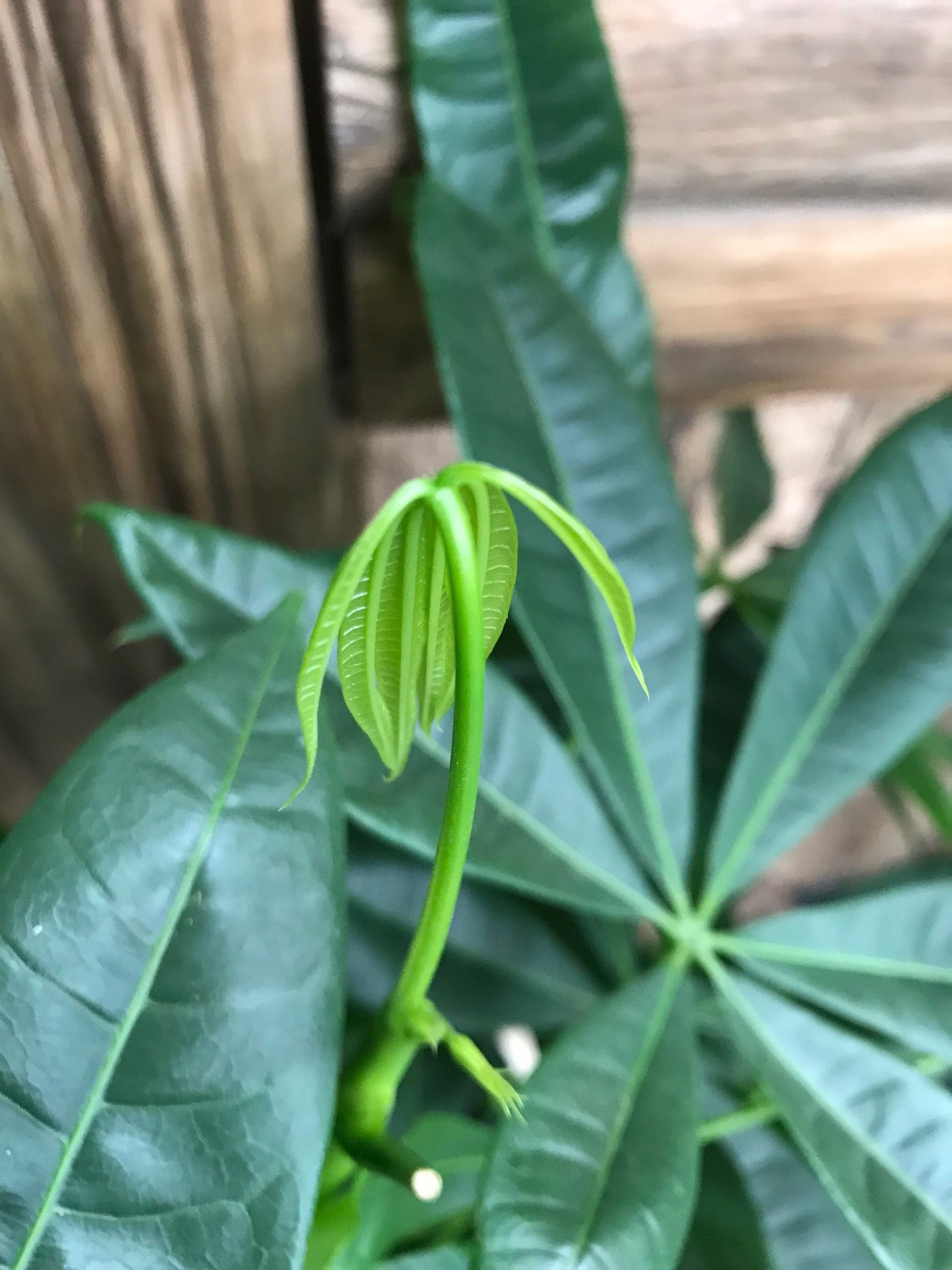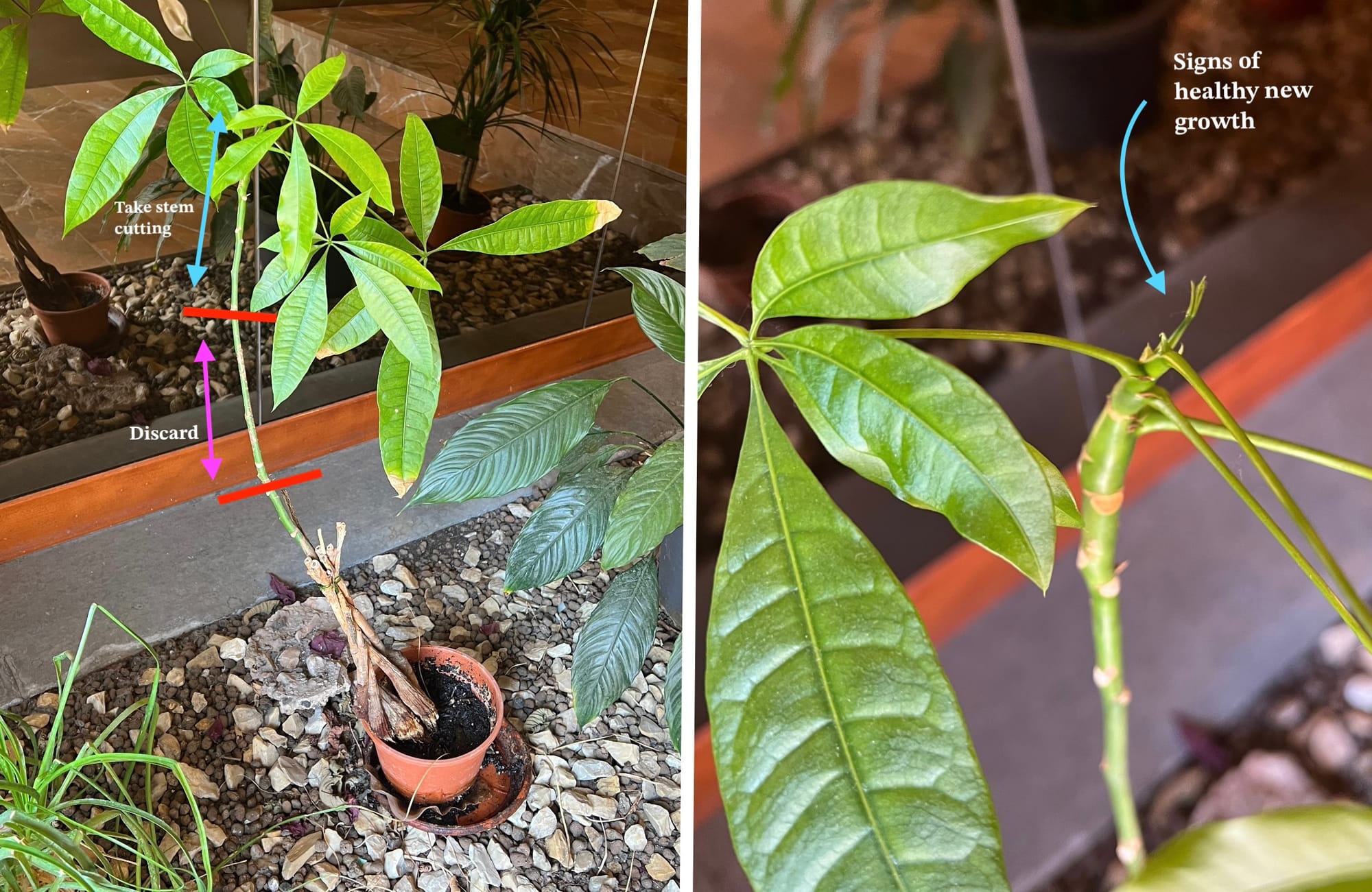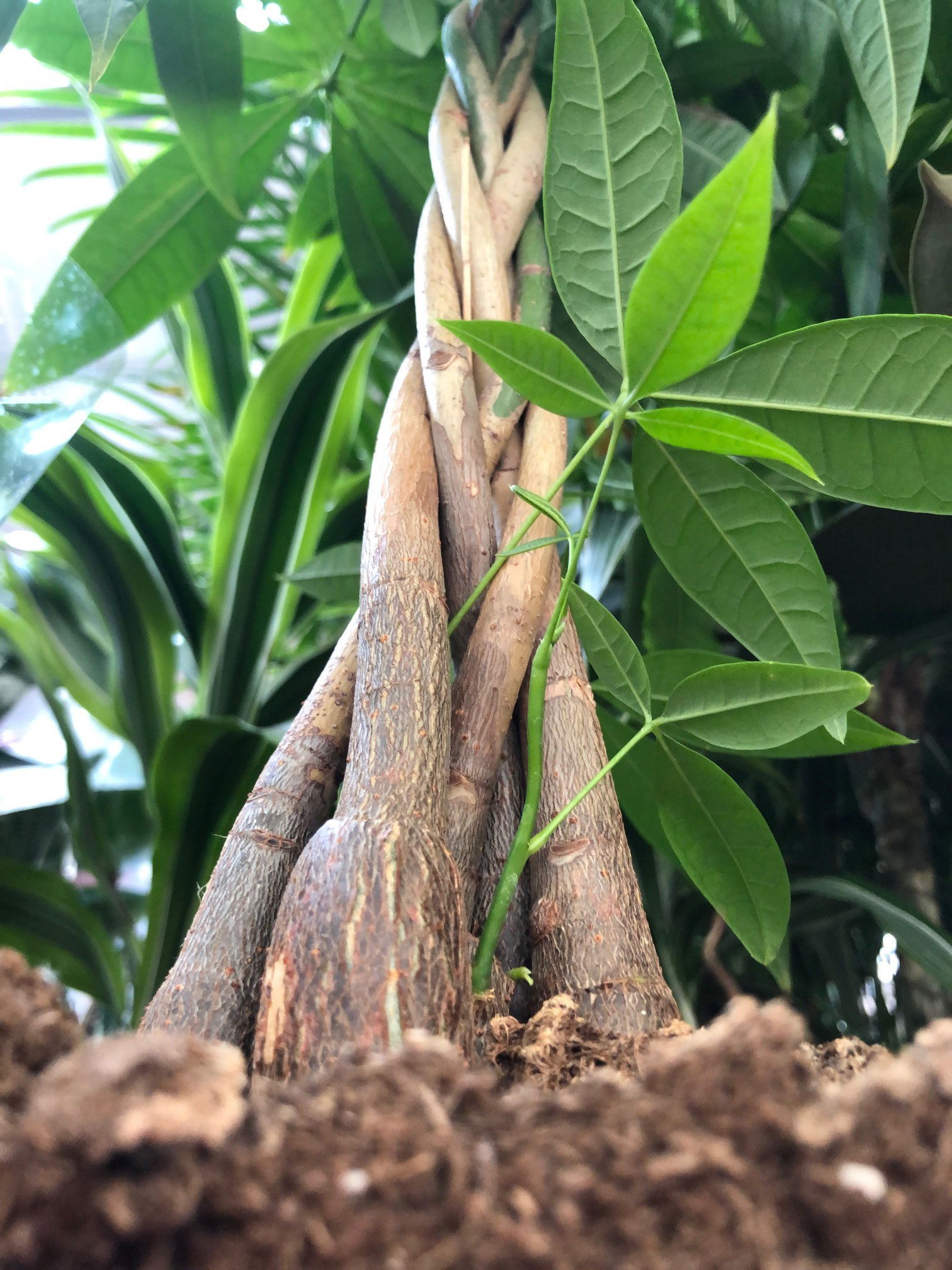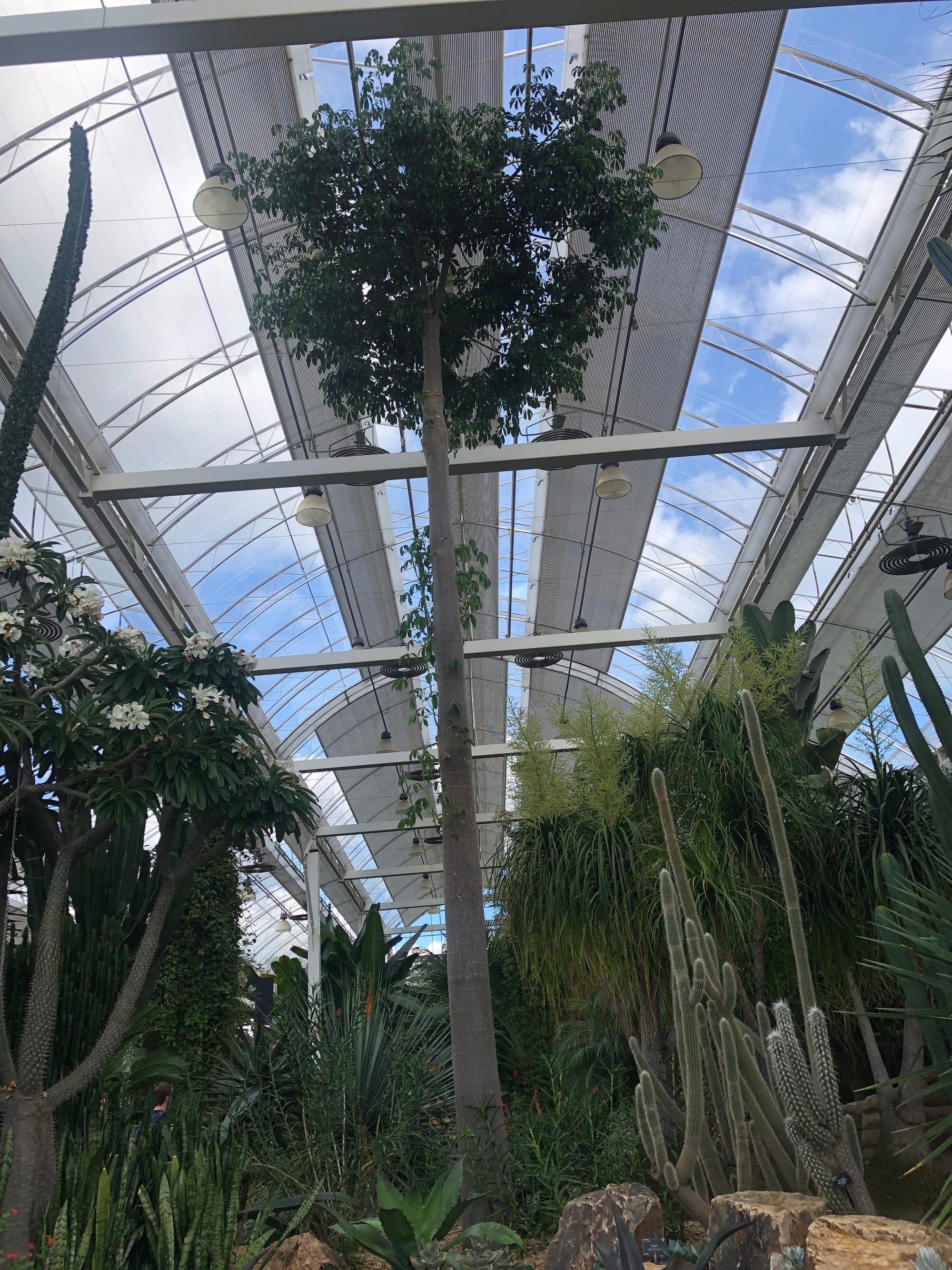
Pachira aquatica
Contents
- Top Tips
- Location, Water, Humidity & Fertilisation
- Common Issues
- Origins, Temperature, Propagation, Repotting & Toxicity.
Need the answer to a specific plant query? Book a 1-to-1 video call with THE HOUSEPLANT DOCTOR™, the website's friendly author, to overcome and address your niggling problem! Available on iMessage, WhatsApp, Facebook Messenger & more.
Top Tips & Info
- Care Difficulty - Moderate
- Present a bright, indirect location, avoiding prolonged exposure to the sun, especially in the summer.
- Allow the top third of the soil to dry out in between waters, especially during the autumn and winter when root rot is at its most severe.
- Provide a decent level of humidity by creating a humidity tray and misting the foliage infrequently.
- Fertilise using a 'Houseplant' labelled feed every four waters in the spring and summer, reducing this to every six in the colder months.
- Repot every three years using a 'Houseplant' labelled compost in the springtime.
- Maintain the 'braided' appeal by regularly weaving the new leading growths in a French Plait - keep the growths tied until they've become fully wooded.
- Yellow leaves indicate inconsistent watering regime; scroll on to 'Common Issues' for further advice on this.
- As the new growth will not naturally sport the braids, it's essential to train the juvenile stems while they're still bendable; scroll down to 'Pruning & Maintenance' for more information.
Location & Light - 🔸🔸
Perfecting the amount of light a Pachira receives is crucial for a long-lasting specimen. During the spring and summer, be sure to provide a brightly lit spot away from any direct light. Excessive exposure during this time will negatively affect the plant in the likes of sun-scorch and dehydration. Once the autumn kicks in, be sure to include an hour or two of direct light per day to get it through the dormancy period.
Water - 🔸🔸
Allow the top third of the soil to dry out in between waters in the growing period, reducing this further in the autumn and winter months. You'll notice that Pachira are situated in a well-draining medium, meaning that standing water could be an issue beneath the pot. If possible, use tepid water as their root systems are super sensitive to temperature change, with potential side effects including weak summer growth and a general decline in health. Under-watering symptoms include grey or yellowing leaves, yellow spots and stunted or deformed growth. Never allow the soil to thoroughly dry out for extended periods, especially in hot spells; failure to do so could result in distorted growth that won't look appealing. Over-watering symptoms include yellowing lower leaves, rotten plant sections and a softened stem. These issues are usually due to too little light or heat, too much water in between waterings, over-potting your Pachira, or standing water beneath the pot. For minor cases, be sure to change its growing environment with a brighter location and fewer irrigations. For more severe cases where the pot is unreasonably heavy with prompt leaf loss, click on the following link to learn more about root rot.
Humidity - 🔸🔸🔸
Always provide a location that has good air circulation and moist air by creating a humidity tray to increase the local atmospheric saturation. Signs of an under-humid room consist of yellowing leaves, browning leaf tips and slowed growth. If this has happened to your specimen, instead of removing the browned leaf-edges, increase the local humidity with a pebble tray and frequently mist the foliage twice a week for the next month. Wait until the leaf's majority has browned or yellowed over before cutting it off.
Fertilisation - 🔸🔸
Feed every four waters during the growing period and every six in the autumn and winter, using a 'Houseplant' labelled fertiliser. Never apply a 'ready to use’ product into the soil without a pre-water first, as it may burn the roots and lead to yellowed leaves.
Common Issues with Pachira Aquatica
Root rot is a common issue with specimens sat in too moist or waterlogged soil for long periods. Symptoms include rapidly yellowing leaves, stunted growth and a rotten brown base. Take the plant out of the pot and inspect health below the soil line. If the roots sport a yellow tinge, you're good to go, but if they're brown and mushy, action must be taken immediately. More information about addressing root rot can be found on this link.
Spider Mites are small, near-transparent critters, that'll slowly suck out the chlorophyll out of the leaves. Have a check under the leaves, most notably along the midrib, for small webs and gritty yellow bumps. Click here to read our article about the eradicating Spider Mites, along with some extra tips that you may not find elsewhere!
Too low humidity can cause browning leaf tips with yellow halos. Although this won't kill your specimen, you may want to increase the local moisture to prevent the new growth from adopting these symptoms. Mist or rinse the foliage from time to time and create a humidity tray whilst the heaters are active to create a stable environment for your specimen.
White dusty markings on your Pachira are just mineral deposits from hard water. If you live in an area with this, try using an aquatic water softener like 'Seachem Prime' that'll remove hard metals, minerals and chlorine. You can also use this to wipe the leaves to remove the dusty markings.
Transplant shock is a big issue when it comes to heavy-handed repots. Give the plant a good soak 24hrs before the action and never tinker with the roots, unless it has been affected by root rot. Typical signs of transplant shock are largely similar to under-watering, with wilting, yellowing leaves and stunted growth among the most common symptoms. Click here to learn more about addressing transplant shock, and a step-by-step guide on performing the perfect transplant.
Curled leaves and dried brown edges are the result of too little water and over-exposure to the sun. Those that haven't acclimatised to the morning or evening rays will show signs of sun-scorch and environmental shock. Gradually increase the amount of light every few days, starting from an indirect location to a few hours of morning/evening sun over a few weeks. Prolonged exposure will significantly speed the process of dehydration, so consider transplantation into a bigger pot in the Spring to wrap the roots around moister soil.

This is a healthy, but leggy Pachira aquatica caused by insufficient light. THE HOUSEPLANT DOCTOR™ recommends one of two things; either increase your plant's light levels by relocating it closer to a window OR you can prune the plant back. Prune the spindly stem via the two red lines (left image) and discard the middle. Relocate the bottom half of the plant (still in the soil) in the sunniest, warmest windowsill in your house. Water only once the top third of the soil dries out and feed once every third water to promote new stems. For the top bit of the cutting, place it in water to propagate and pot-up once the roots are around 7-8cm (3in) in length. how to save my spindly dying leggy pachira aquatica money plant chestnut Guiana
Distorted growth is a typical trait of under-watering or inconsistent irrigations. Remember to only allow the top third of the soil to dry out during the spring and summer months for the prevention of dehydration. Click on this link to learn about how not to water a houseplant.
If your specimen is located in a dark environment, use a chopstick to gently stab the soil in various areas. You should aim to enter the compost between the base of the plant and the pot's edge, as failure to do so may lead to damaging its lower portion. Leave the holes open for a few days before re-surfacing the soil to avoid it becoming overly dry. Not only will the gentle shift in the soil's structure mimic the work of small invertebrates in the wild (worms, etc.), but it'll also add oxygen back into the soil, thus reducing the risk of root rot. Repeat this monthly, or whenever you feel the potting-mix isn't drying out quickly enough.
Lower leaf loss is a common and significant issue among gardeners. This unfortunate phenomenon could be a product of several different problems, most notably being dark locations, water-related abuse or environmental shock. Introduce the plant to a more well-lit area with a splash of off-peak sunlight; if caught in time, the leaf loss should stop within a week. If you feel that you're watering habits aren't up to scratch, familiarise yourself with our care tips provided at the top of this article. It's always best to under-water a Pachira than over-do it, purely on its poor ability to endure continued sogginess. The final culprit could be down to a sudden relocation; if you've recently purchased the specimen, the chances are it is still acclimatising to the new environment. Although this shouldn't happen, a vastly different setting will cause sudden foliage loss and stunted growth. You'll have two options of either waiting it out or presenting a more Pachira-friendly environment, mentioned in the 'Location & Light' section.
Mould developing on the soil means two things - too little light and periods of overly moist soil. Despite the harmlessness of the mould, it'll prove unsightly to most gardeners and is often removed. To remove, replace the top two inches of the soil for a fresh batch of 'Houseplant' compost, or preferably coconut-coir based soil like this hyperlinked product. Either increase the amount of light received (no direct sunlight for the first few weeks to prevent environmental shock) or decrease the frequency of waters slightly. If the mould is accompanied by yellowing lower leaves, you may also have a case of root rot.
 An excellent example of the iconic trademark stems associated with Pachira. Did you know that you can carry on the plaits by bending juvenile stems and loosening off the ties once they become wooded and secure.
An excellent example of the iconic trademark stems associated with Pachira. Did you know that you can carry on the plaits by bending juvenile stems and loosening off the ties once they become wooded and secure.
Origins
Pachira has natural distributions across tropical America and was first described by Jean Fusée-Aublet in 1775. Its name derives from Guyanese Indian meaning 'sweet water nut', which is in reference to the tendency to grow nearby riverbanks and swamps. Although specimens can grow up to twenty metres in the wild, expect heights of around three metres with a width of a metre.
 The Distribution of Pachira aquatica.
The Distribution of Pachira aquatica.
Temperature
15° - 32°C (59° - 90°F)
H1a (Hardiness Zone 13) - Must be grown indoors or under glass all year round. Never allow temperatures to dip below 15℃ or permanent damage may occur in the likes of flower loss, stunted growth and yellowed leaves.
Spread
Over 3m (10ft) in height and 1.4m in width once they reach maturity indoors. The ultimate height will take between 5 - 10 years to achieve, with up to 15cm of new growth per season.
 In the wild, Pachira aquatica can grow at least 10m (33ft). Here's a 5m specimen grown in one of the RHS Wisley's glasshouses.
In the wild, Pachira aquatica can grow at least 10m (33ft). Here's a 5m specimen grown in one of the RHS Wisley's glasshouses.
Pruning & Maintenance
Remove yellow or dying leaves, and plant debris to encourage better-growing conditions. While pruning, always use clean scissors or shears to reduce the chance of bacterial and fungal diseases. Never cut through yellowed tissue as this may cause further damage in the likes of diseases or bacterial infections. Remember to make clean incisions as too-damaged wounds may shock the plant, causing weakened growth and a decline in health.
New growths must be braided regularly to maintain its eye-catching trunk; loosely tie the newly plaited stems until they become fully wooded in the following months. It's essential to weave the new growths whilst they are juvenile, as semi-wooded stems are less likely to bend. You can use chicken wire, jute, or even cable ties to fasten the new braids securely.
Propagation
Via Seed & Stem Cuttings (Moderate).
Stem Cuttings can be taken at the start of spring when there's more than 20cm of semi-wooded stem, located at the top of each branch. You can do this with leggy specimens as seen in the 'Common Issues' section above. This will take a while, as the plant will need to reach a certain level of maturity before its base becomes ready. While using clean secateurs, remove the top end of the stem just above a node. Gently remove the lower leaves and set the bottom half of the stem into water for root development. After 7cm (3in) of root growth, set the rooted portion into a moist, well-draining potting mix. Although we'd recommend using a 'Houseplant' labelled soil, a general-purpose compost with added perlite and sand will work wonders, too. As long as there is a splash of perlite introduced into the mix, oxygen will flow liberally around the cutting's base to reduce the risk of basal rot. Wrap the plant (& its pot) in a transparent bag to maintain high humidity, due to the absence of roots that'll result in rapid moisture loss within the stem. Provide a bright, indirect location with continual soil moisture to quicken the rate of root development. Remove the bag after three weeks of substantial foliar growth and follow the care advice provided at the top of the article.
Flowers
Pachira can produce large flowers with elongated yellow petals several times during its lifetime; however, domestically grown specimens may never bloom. If pollination is successful, the flowers will turn into brown fruits that hold nuts which can be used as a substitute for cocoa.
Repotting
Repot every three years in the spring, using a 'Houseplant' labelled compost and the next sized pot with adequate drainage. Hydrate the plant 24hrs before tinkering with the roots to prevent the risk of transplant shock. For those that are situated in a darker location, add a thin layer of small grit in the pot's base to improve drainage and downplay over-watering. Click here for a detailed step-by-step guide on transplantation, or via this link to learn about repotting with root rot.
Book a 1-to-1 video call with THE HOUSEPLANT DOCTOR™ if you'd like a personal guide to repotting your houseplant. This will include recommending the right branded-compost and pot size, followed by a live video call whilst you transplant the specimen for step-by-step guidance and answer any further questions!
Pests & Diseases
Keep an eye out for mealybugs, aphids, spider mites, scale, thrips & whitefly that'll locate themselves in the cubbyholes and undersides of the leaves. Common diseases are root rot, leaf-spot disease, botrytis, powdery mildew & southern blight - click here to learn more about these issues.
Toxicity
This plant is classified as non poisonous. If, however, large parts of the plant are eaten - like the stems or foliage - there may be issues of vomiting or nausea with sensitive pets!
Retail Locations
IKEA, B&Q, Online Stores.
Book a 1-to-1 Call with THE HOUSEPLANT DOCTOR™
If you need further advice with your houseplants, book an advice call with ukhouseplants' friendly and expert writer today! This can be done via a video or audio call on most apps, including Facebook, FaceTime & Skype. A ten-minute call costs £5.99 (US$7), or £15.99 for thirty minutes. You can ask multiple questions, including queries on plants, pests, terrariums, repotting advice and anything in between. Please consider supporting this service to keep ukhouseplants thriving!